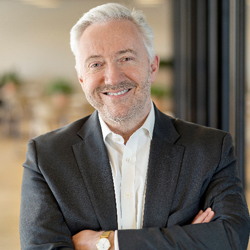Clinical Researcher—May 2020 (Volume 34, Issue 5)
CHAIR’S MESSAGE
Paul Evans, PhD
Welcome to the new normal. Masks when leaving the house. Waves, not handshakes. Virtual happy hours via Zoom. Strange days to be sure.
I’m sure your life has been impacted in ways difficult to imagine even a few months earlier. Working from home every day. Maybe parenting or taking care of another loved one or friend in semi-confinement. Think of how much has changed since the world was packed with people-to-people celebrations on New Year’s Eve. It was less than 150 days ago, but it’s hard to imagine it happening at the moment, isn’t it?
Well, we’re going to have to confront these and other changes if we want to move forward as a society. In the clinical trials space, it may be even more challenging for us to restart our industry. It isn’t just a case of opening the doors and expecting patients to come back because we feel ready. The stakes are high on a number of levels. Stalled clinical trials mean stalled medical advances. The financial pressures on our industry may not be getting the same sort of media attention as some others, understandably, but those pressures are there.
The contract research organizations (CROs) quoted on the stock market have been reporting their first quarter results in the last week or so, and taken together they paint an interesting picture of where we find ourselves:
- Many sites are not accessible in the current climate, so most actively recruiting studies were put on hold for sound, practical reasons.
- Most of the income that keeps sites and CROs afloat comes from actively recruiting studies rather than those closed to recruitment. Around two-thirds of income is made up this way, so the closure to recruitment of studies is a huge hit.
- The vast majority are forecasting a slump in trial activity in Q2, but a fairly quick return to normal through Q3 and a strong Q4 for 2020.
While there are signs that some sponsors are beginning to lift their recruitment holds, it appears to be occurring in a piecemeal fashion on a site-by-site basis. There has been no national uptick as of yet. Regardless, sponsors will want to ensure the safety of patients and their staff who have to visit sites, so they will be selective in which sites they re-initiate.
Some sites have never closed and will be able to pick up immediately, while others are still some way from even thinking about it. Hospitals are still a difficult place to operate for obvious reasons, and a state like New York still has a major battle on its hands with COVID-19. Let’s pay tribute to the hospital sites everywhere which have managed to do critical COVID-19 treatment protocols under what must have seemed like war time conditions.
And as noted earlier, we can’t assume patients will automatically return to sites or otherwise participate in clinical trials. We have to address their concerns head-on with maintaining social distancing, stressing hygiene, screening patients for the coronavirus, and working with personal protective equipment, among other tools and tactics to assure them we are operating in the safest manner possible.
Together, we can come back strong as an industry. It won’t be the same, however, and we do ourselves and our patients a disservice if we try to pretend otherwise. Let’s learn from this difficult experience. Let’s build more patient-friendly trials with greater flexibility and less complicated protocols.
Welcome to the new normal. Let’s get to work.
Paul Evans, PhD, is President and CEO of Velocity Clinical Research, and Chair of the Association Board of Trustees for ACRP in 2020.



